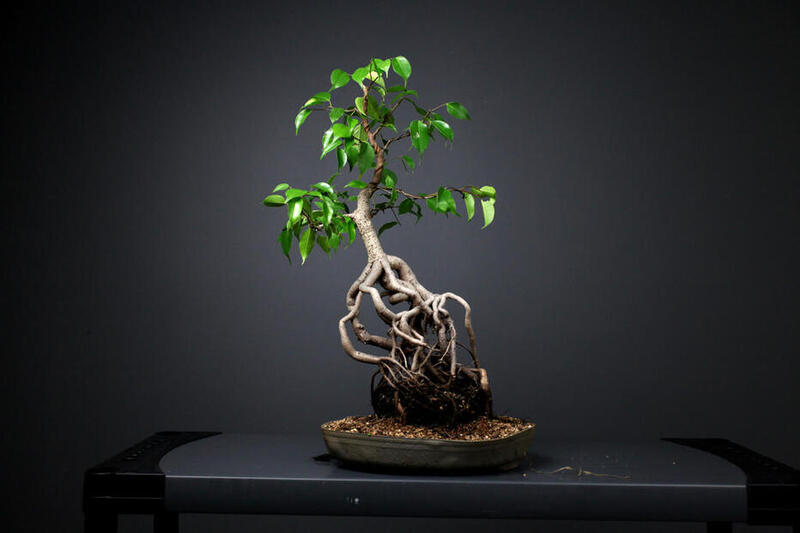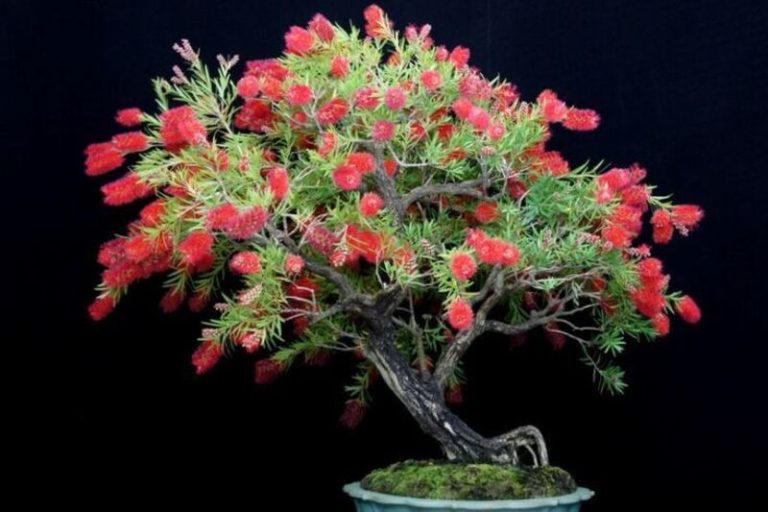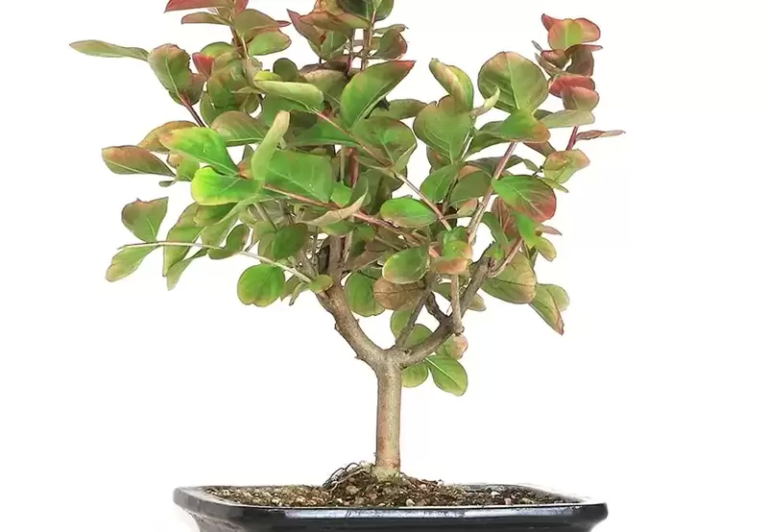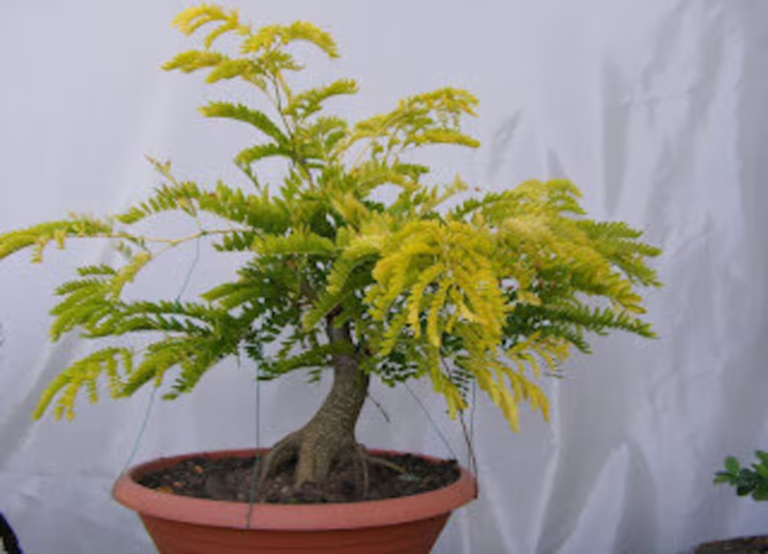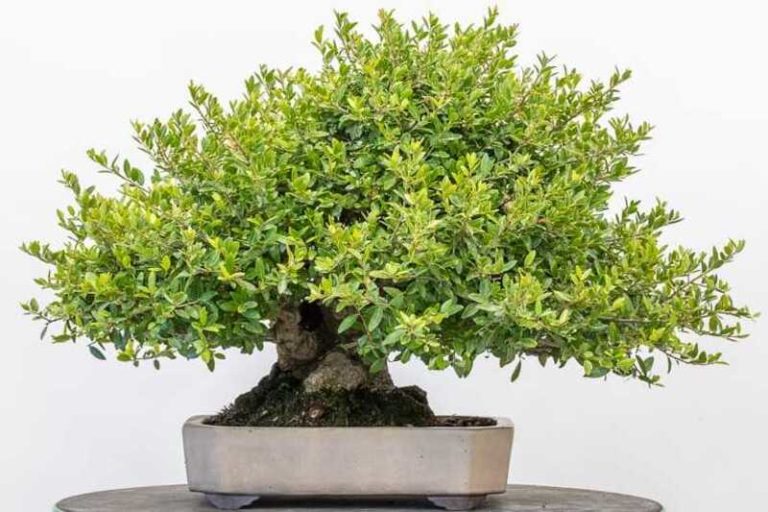Exposed Root Bonsai : Unveiling the Artistry and Intricacy
Exposed root bonsai is a special kind of bonsai tree whose roots are beautifully presented above the ground. The unique look of these bonsai trees has made them famous among fans. In this article, we’ll learn about exposed-root bonsai, how to care for them, and what they mean in Japanese culture.
What is an Exposed Root Bonsai?
Exposed root bonsai is a style of bonsai where the roots of the tree are deliberately displayed above the soil surface. It is a visually striking and artistic approach that adds character and beauty to the bonsai. The roots are carefully pruned and shaped to create an appealing design, and they become the focal point of the tree. Exposed root bonsai has a rich history and is considered an advanced style, requiring skill and patience. It is a unique way to connect with nature and showcase the beauty of trees in miniature.
History and Origins of the Exposed Root Bonsai
The history and origins of exposed root bonsai can be traced back to ancient China and Japan. Bonsai, as an art form, has its roots in China, where it was initially practiced as a way to depict miniature landscapes. The art of bonsai then spread to Japan, where it evolved and became deeply ingrained in Japanese culture.
In both China and Japan, the art of bonsai was influenced by Zen Buddhism, which emphasized harmony with nature and the pursuit of simplicity and tranquility. Bonsai became a means for practitioners to express their spiritual and artistic aspirations.
As a creative representation of this art form, exposed root bonsai evolved. The intentional exposure of roots above the soil surface demonstrated the tree’s connectedness to its surroundings. It expressed the concept that a tree’s roots are not just concealed beneath the earth, but are an essential element of its beauty and character.
Exposed root bonsai exemplified the skill and artistry of bonsai masters who carefully trained and shaped the roots to create visually appealing compositions. The technique of manipulating the roots to create intricate patterns and designs became a hallmark of this style.
Exposed root bonsai acquired popularity and recognition over time, both within the bonsai community and among art fans worldwide. It has become one of the most distinctive and sought-after bonsai styles, exhibiting the inventiveness and originality of bonsai artists.
Today, exposed root bonsai continues to be practiced and appreciated globally. Bonsai enthusiasts and artists draw inspiration from the rich history and cultural significance of this style, as they continue to innovate and create their own unique expressions of exposed root bonsai.
Exposed Root Bonsai and Their Symbolism
Exposed root bonsai carry symbolic meanings that go beyond their aesthetic appeal. These symbolic associations are deeply rooted in the traditions and philosophies that have shaped the art of bonsai over the centuries. Here are some common symbolic interpretations of exposed root bonsai:
Connection to Nature:
Exposed root bonsai represents the intimate connection between trees and their natural environment. The exposed roots symbolize the tree’s strong bond with the earth, emphasizing the importance of staying grounded and rooted in one’s origins.
Resilience and Endurance:
The exposed roots of a bonsai tree often display intricate and twisted forms, reflecting the resilience and endurance of nature. It signifies the ability to adapt and thrive even in challenging circumstances, inspiring individuals to face obstacles with strength and determination.
Wisdom and Timelessness:
With its ancient look, exposed root bonsai represent wisdom and timelessness. They remind us of the collected knowledge and the ageless essence of the natural world. It fosters awe for the knowledge of the past and a greater grasp of the passing of time.
Balance and Harmony:
The artistry of exposed root bonsai lies in creating a harmonious balance between the roots, branches, and foliage. It represents the pursuit of balance and harmony in all aspects of life. The careful arrangement of the exposed roots symbolizes the need for balance between the visible and hidden aspects of our existence.
Tranquility and Serenity:
Exposed root bonsai evokes a sense of tranquility and serenity, inviting viewers to find inner peace and calmness. The delicate and meticulous arrangement of the roots serves as a reminder to seek tranquility amidst the chaos of the world.
Reflection of the Microcosm:
Exposed root bonsai is a good example of the idea of a microcosm because it shows a whole landscape or environment in a small size. It stands for the idea that the spirit of nature can be caught in a small bonsai tree and thought about in its small space.
Connection to Spiritual Practice:
In Zen Buddhism, bonsai with roots that are visible have a spiritual meaning. It shows the Zen ideas of simplicity, being aware of the present moment, and appreciating beauty in everyday life. Taking care of a bonsai tree can be a way to meditate and think about things.
In Zen Buddhism, bonsai with open roots have a spiritual meaning. It shows the Zen values of simplicity, being aware of the present moment, and appreciating beauty in everyday life. Taking care of a bonsai tree can be a way to relax, think, and meditate.
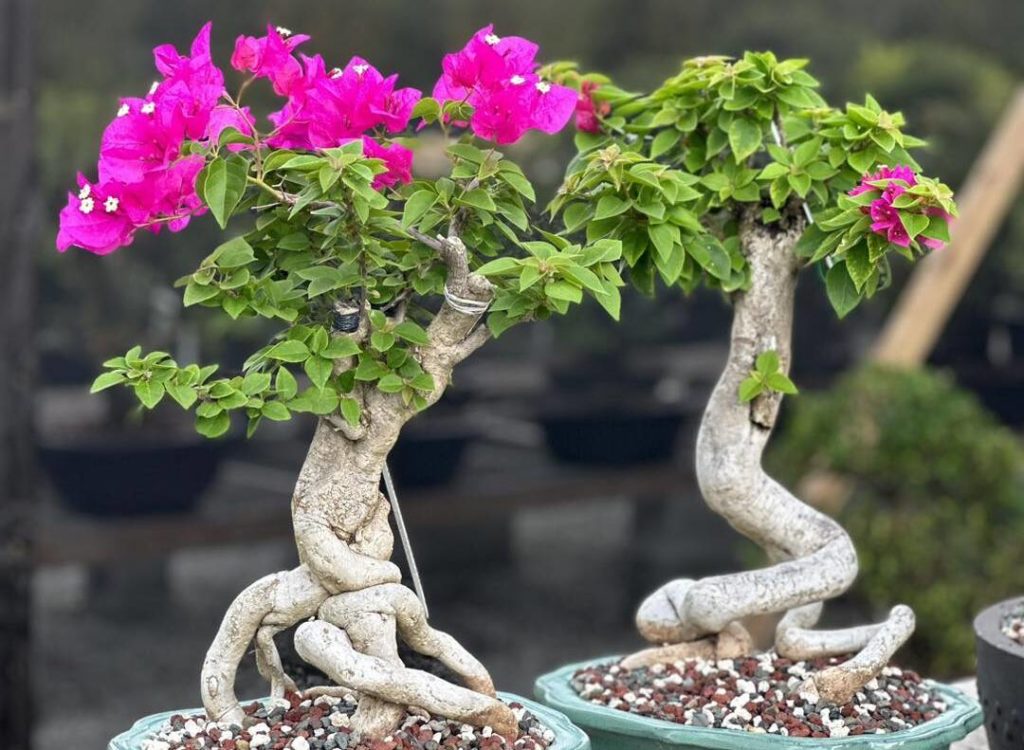
Characteristics of the Exposed Root Bonsai
Exposed root bonsai possesses several distinct characteristics that set it apart from other bonsai styles. These characteristics contribute to the unique and captivating appearance of exposed root bonsai trees. Here are some key features of exposed root bonsai:
- Displayed Roots: The most noticeable thing about exposed root bonsai is that the tree’s roots are shown above the surface of the dirt. The roots are carefully cut, shaped, and placed to make patterns and designs that look good. The bonsai tree’s uncovered roots become its main feature and give it a feeling of age and personality.
- Artistic Root Formations: Exposed root bonsai often feature intricate and artistic root formations. The roots may be trained to grow in twists, curves, or gnarled patterns, enhancing the overall aesthetic appeal. These artistic root formations evoke a sense of natural beauty and create a visually striking composition.
- Visual Balance: An Exposed root bonsai embodies a sense of visual balance and harmony. The arrangement of the roots, branches, and foliage is carefully considered to achieve a pleasing and balanced composition. The exposed roots serve as a counterpoint to the above-ground elements of the tree, contributing to the overall visual equilibrium.
- Naturalistic Aesthetics: Exposed root bonsai aims to capture the essence of nature in miniature form. The overall design and appearance of the tree reflect the natural growth patterns and characteristics of trees found in the wild. The exposed roots give the bonsai a sense of authenticity and a connection to its natural environment.
- Sense of Age and History: Bonsai with roots that are visible often give off a sense of age and history. With their weathered look and complicated shapes, the uncovered roots give the image of an old tree that has stood the test of time. This gives the bonsai more meaning and a story to tell. It also makes you respect the wisdom and strength of nature.
- Symbolic Significance: As we’ve already talked about, exposed root bonsai have a metaphorical value. The visible roots add to the symbolism of the bonsai and give it more depth and meaning as a whole.
- Artistic Expression and Creativity: The creation of exposed root bonsai allows for artistic expression and creativity. Bonsai artists can experiment with various root arrangements, shapes, and designs, pushing the boundaries of the art form. The unique and personal touch of each artist shines through in the creation of exposed root bonsai.
All of these things make open root bonsai so interesting and appealing. They show the attention to detail, artistic vision, and respect for nature that are important to this type of bonsai.
How to Grow an Exposed Root Bonsai
Growing an exposed root bonsai requires careful attention to the tree’s root system, pruning techniques, and overall maintenance. Here are the general steps to growing an exposed root bonsai:
Selecting a Suitable Tree Species: Choose a tree species that is suitable for bonsai cultivation and can thrive with exposed roots. Popular species for exposed root bonsai include Ficus, Juniper, Pine, and Elm. Consider the climate, light requirements, and overall growth habits of the tree species before making a selection.
Obtaining a Healthy Nursery Plant: Get a healthy young tree from a bonsai provider or farm you can trust. Look for a tree with a straight, strong base and a strong root system. Avoid plants with bad roots or signs of poor health, like leaves that are turning yellow or stems that are getting weak.
Pruning and Styling the Roots: When the tree is ready for styling, carefully remove the tree from its container and gently untangle and prune the roots. Trim away any damaged or excessively long roots, keeping the primary structural roots intact. Shape the remaining roots to create an appealing exposed root design. Use bonsai wire or root hooks to guide the roots into the desired positions. Be cautious not to damage the delicate root structure during this process.
Choosing a Suitable Pot: Select a shallow and appropriately sized bonsai pot that complements the style and size of your exposed root bonsai. Ensure that the pot has sufficient drainage holes to prevent waterlogging. The pot should provide stability and support for the tree while allowing for future root growth.
Soil and Potting: Use a combination of bonsai soil that drains well and lets water and air reach the roots. In a normal mix, Akadama, pumice, and lava rock are all used. Place the tree gently into the bonsai pot, spreading out the roots and making sure they touch the soil well. Bonsai dirt can be used to hold the roots of the tree in place.
Watering and Fertilizing: Water the exposed root bonsai thoroughly, ensuring that the water reaches all parts of the root system. Avoid overwatering, as excessive moisture can lead to root rot. Allow the soil to partially dry out before watering again. Fertilize the bonsai regularly during the growing season with a balanced bonsai fertilizer, following the manufacturer’s instructions.
Pruning and Training: Regularly prune and shape the branches to maintain the desired form and size of the bonsai. Use bonsai wire to guide and shape the branches as needed. Pruning helps maintain the overall balance and structure of the tree. Remove any dead, weak, or overcrowded branches to promote healthy growth.
Sunlight and Positioning: Put the bonsai with the uncovered roots in a place that gets enough sunshine. Most tree species do best in a spot that gets full or mostly full sunshine for most of the day. Watch how the bonsai reacts to the sun and move it so that it doesn’t get too much sun or too little.
Protection and Winter Care: Protect the exposed root bonsai from extreme weather conditions. In cold climates, provide winter protection by placing the bonsai in a sheltered area or using a cold frame or greenhouse. Protect the roots from freezing temperatures by insulating the pot with a layer of mulch or wrapping the pot with horticultural fleece.
Ongoing Care and Maintenance: Keep an eye on the bonsai’s health and take care of any pests or diseases right away. Check the roots often for signs of root rot or too many roots. Every few years, you should repot the bonsai to refresh the soil and keep the roots from getting too crowded.
By following these steps and providing proper care, you can nurture and grow a beautiful exposed root bonsai tree that will bring years of enjoyment and aesthetic pleasure. Remember to be patient and observe the tree’s growth patterns, adjusting your care accordingly. As the bonsai matures, you can further refine its shape and expose more of the root system, adding to its unique character.
Regularly study and learn about bonsai techniques and practices to enhance your knowledge and skills. Joining a local bonsai club or seeking guidance from experienced bonsai enthusiasts can also provide valuable insights and support on growing and maintaining exposed root bonsai.
Lastly, remember that a bonsai with open roots is a live piece of art that needs care and attention all the time. Take pleasure in caring for and creating the tree, and let it show your creativity and respect for the beauty of nature.
Benefits of the Exposed Root Bonsai
The exposed root bonsai offers several benefits that make it a captivating and rewarding style of bonsai to grow and appreciate. Here are some key benefits of exposed root bonsai:
- Aesthetic Appeal: Exposed root bonsai possess a unique and visually striking appearance. The deliberate display of the tree’s roots above the soil surface adds a sense of intrigue, depth, and character to the bonsai. It becomes an artistic focal point, drawing attention and admiration from viewers.
- Artistic Expression: Growing exposed root bonsai allows for creative expression and artistic interpretation. Bonsai enthusiasts can experiment with different root arrangements, shapes, and designs, showcasing their personal style and vision. The artistry involved in training and shaping the exposed roots adds an element of craftsmanship and ingenuity to the bonsai.
- Symbolism and Meaning: As we’ve already talked about, a tree with its roots showing has spiritual meaning. The way the roots are displayed shows ideas like strength, balance, and a link to nature. Bonsai is an important and thought-provoking form of art because the symbols give it depth and help tell a story.
- Natural Beauty in Miniature Form: Bonsai with exposed roots shows the heart of nature on a small scale. It lets us see how beautiful trees and their root systems really are. The bonsai becomes a tiny scene that is alive and lets us connect with and be amazed by the beauty of nature.
- Educational and Therapeutic Value: Growing exposed root bonsai provides an opportunity for learning and personal growth. It encourages an understanding of tree biology, root development, and horticultural practices. Tending bonsai can also be a therapeutic and meditative activity, promoting relaxation, mindfulness, and a sense of connection with nature.
- Longevity and Legacy: Bonsai with exposed roots could become historical pieces that are passed down from one family to the next. With the right care and upkeep, these bonsai trees can live for decades or even centuries, becoming treasured family heirlooms and symbols of continuity and memory.
- Bonsai Community and Appreciation: Bonsai fans all over the world enjoy and admire bonsai with roots that are visible. When you join the bonsai community, you can share your knowledge, go to shows and classes, and meet other people who value the art of bonsai.
The exposed root bonsai is a way to connect with nature and enjoy the beauty of trees in a small way that is both beautiful and artistic. It blends beauty, meaning, and personal creation, which makes it a satisfying and enriching hobby for bonsai fans of all skill levels.
Displaying and Showcasing the Exposed Root Bonsai
Displaying and showcasing an exposed root bonsai is an important aspect of enjoying and sharing the beauty of this unique bonsai style. Here are some tips on how to effectively display and showcase your exposed root bonsai:
1. Choose an Appropriate Stand: Select a bonsai stand or display table that complements the style and size of your exposed root bonsai. The stand should provide stability and elevate the bonsai, allowing it to be viewed from various angles. Consider using a stand made of natural materials, such as wood or stone, to enhance the natural aesthetic.
2. Consider the Background: When deciding where to put your exposed root bonsai, think about what it will look like against the background. A simple, clean background, like a plain wall or a solid-colored backdrop, can help show off the bonsai’s complex root design and general beauty. Avoid backgrounds that could take away from or hide the bonsai’s beauty.
3. Lighting: To see the features and textures of the uncovered roots, you need the right lighting. The best light for a bonsai is natural light, so put it near a window or in a well-lit area. If there isn’t much natural light, you could use LED lamps or other fake lighting to light up the bonsai and make it look nice.
4. Rotation and Viewing Angles: Regularly rotate your exposed root bonsai to ensure all sides and angles are equally showcased. By rotating the bonsai, you allow viewers to appreciate the different perspectives and details of the exposed roots. Experiment with different viewing angles to find the most visually appealing presentation.
5. Consider Companion Elements: Enhance the overall display by incorporating complementary elements such as accent plants, rocks, or figurines. These elements should not overpower the bonsai but rather provide a harmonious backdrop or focal point that enhances the overall aesthetic. Select companion elements that align with the naturalistic theme of the exposed root bonsai.
6. Participate in Exhibitions and Shows: Showcasing your exposed root bonsai in bonsai exhibitions or shows is a wonderful way to share your creation with a wider audience and receive feedback from fellow enthusiasts. Participating in such events can also provide opportunities to learn from experienced bonsai artists and gain inspiration for future displays.
7. Regular Maintenance: If you want to keep your exposed root bonsai in the finest condition for display, regular maintenance is crucial. This include pruning, wiring, repotting, and ensuring the tree’s wellbeing. In addition to looking great, a well-kept bonsai will demonstrate the effort and consideration you put into its growth.
Remember, the display of an exposed root bonsai is a personal expression of your artistic vision and appreciation for nature. Experiment with different presentation styles and find a display approach that best highlights the unique characteristics and beauty of your bonsai.
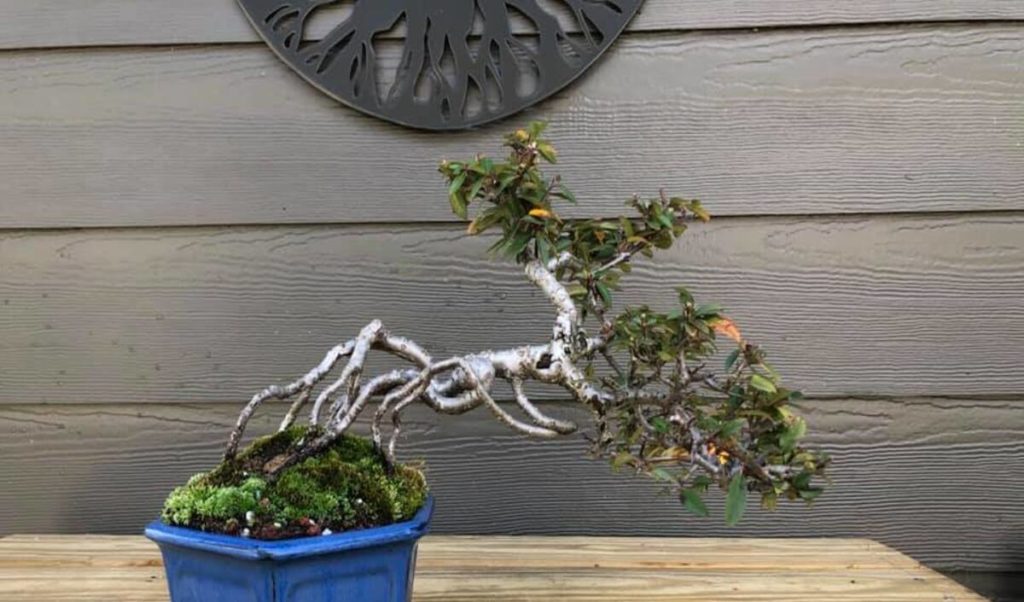
Styling and Design of an Exposed Root Bonsai
The styling and design of an exposed root bonsai require careful consideration and attention to detail. Here are some key aspects to keep in mind when styling and designing an exposed root bonsai:
Selecting the Right Tree Species: Choose a type of tree that does well as an exposed-root bonsai. Ficus, Juniper, Pine, Elm, and Trident Maple are all popular species used in this style. Before making a choice, think about how the species grows, how its roots look, and how it looks generally.
Planning the Root Arrangement: Before styling the exposed roots, envision the desired design and overall composition of the bonsai. Plan the placement and orientation of the roots, keeping in mind the principles of balance and harmony. Create a visually pleasing arrangement that complements the trunk and branch structure of the bonsai.
Pruning and Shaping the Roots: Carefully prune and shape the roots to achieve the desired exposed root design. Remove any excess or unnecessary roots, focusing on creating a balanced and aesthetically pleasing arrangement. Avoid removing too many roots, as they play a vital role in nutrient uptake and overall tree health.
Emphasizing Naturalistic Patterns: The exposed roots should exhibit naturalistic patterns and flow. Aim for a design that mimics the appearance of roots in nature, with twists, curves, and interesting shapes. Avoid excessive uniformity or overly symmetrical arrangements, as they may appear unnatural.
Balancing the Above-Ground Elements: The design of the exposed root bonsai should be in harmony with the above-ground components, such as the trunk, branches, and foliage. Ensure that the overall composition is visually balanced and pleasing to the eye. The exposed roots should complement and enhance the beauty of the tree’s above-ground structure.
Enhancing Age and Character: Bonsai with exposed roots often try to show how old and unique the plant is. Encourage the roots to have worn textures, complex shapes, and patterns that look like they came from nature. The design should make it look like an old tree that has stood the test of time.
Attention to Proportions: Pay close attention to the proportions of the exposed root bonsai. The size and thickness of the exposed roots should be in proportion to the trunk and overall size of the tree. Avoid roots that appear too thin or overly thick in relation to the rest of the tree, as this can create an unbalanced or unnatural appearance.
Patience and Iterative Refinement: Styling and designing an exposed root bonsai is an iterative process that requires patience and careful observation. Continuously refine the design over time, making adjustments as the tree grows and develops. Regularly evaluate the tree’s progress and make necessary changes to maintain the desired aesthetic.
Remember, each exposed root bonsai is a unique expression of art and nature. Embrace your creativity and personal style as you design and style your bonsai, while also respecting the natural beauty and growth patterns of the tree. With time, practice, and a keen eye for detail, you can create a stunning exposed root bonsai that captures the imagination and admiration of viewers.
How to Care for and Maintain an Exposed Root Bonsai
Caring for and maintaining an exposed root bonsai is essential to ensuring its health, vitality, and long-term beauty. Here are some important care guidelines to follow:
- Watering: Proper watering is crucial for the health of your exposed root bonsai. Water the tree thoroughly, ensuring that the water reaches all parts of the root system. Use a watering can or a gentle spray to avoid disturbing the soil or damaging the delicate roots. Avoid overwatering, as it can lead to root rot. Allow the soil to partially dry out between watering sessions to prevent waterlogged conditions.
- Fertilizing: The bonsai needs to be fertilized regularly to get the nutrients it needs for growth and development. Use a balanced, slow-release fertilizer for bonsai or a liquid fertilizer made especially for bonsai. Follow the directions from the maker for how much to use and how often. Fertilize the bonsai when it is growing, normally from spring to early fall, and cut back or stop fertilizing it when it is not growing.
- Pruning and Trimming: Prune and trim your exposed root bonsai regularly to maintain its desired shape, size, and overall health. Remove any dead, damaged, or crossing branches. Trim back new growth to encourage ramification and compactness. Pay attention to the roots as well, removing any excess or unwanted growth. Prune with sharp, clean tools to minimize damage and promote faster healing.
- Wiring and Training: Most of the time, you will need to wire your exposed root bonsai to shape and guide the branches and leaves. Use bonsai wire to bend and place the branches gently, being careful not to cause too much damage or stress. Keep an eye on the wire so it doesn’t cut into the twigs, and fix it or take it off when the shape you want is reached. Be careful when connecting near the tree’s visible roots so you don’t cause any damage or trouble.
- Sunlight and Positioning: Most bonsai with exposed roots need a lot of sunshine to grow well. Put your bonsai somewhere that gets the right amount of sunshine for the type of plant you’re growing. Most bonsai species do better when they get full or mostly full sunshine for a few hours a day. But some species may need cover from the strong noon sun or from temperatures that are too high or too low. Watch how the bonsai reacts to the sun and move it so that it gets the most light.
- Repotting: Repotting is needed to renew the soil, improve the health of the roots, and keep the root system from getting too crowded. Your exposed-root bonsai needs a new pot every two to three years, or as often as it needs it, based on how fast it grows. Change the pot in early spring, before the plant starts to grow again. When repotting, you should carefully trim the roots and use a bonsai soil mix that drains well. Cut back any extra or unneeded roots to keep the amount of roots to leaves in balance.
- Protection from Extreme Conditions: Protect your bonsai with open roots from things like frost, strong winds, and burning heat. In cold areas, protect the bonsai from the cold by putting it in a cold frame or greenhouse, or by putting a layer of mulch around the pot. Keep the roots from getting hurt by freezing weather.
- Pest and Disease Control: Check your bonsai with open roots often to see if there are any signs of pests or diseases. Aphids, spider mites, and scale insects are all common pests of bonsai. Use the right tools, like insecticidal soap or gardening oil, to take care of pests right away. Make sure there is good airflow around the tree and keep the area clean to keep it from getting sick.
- Ongoing Observation and Adjustment: Keep an eye on your exposed root bonsai for any changes in growth patterns, leaf color, or overall health. Adjust your maintenance regimen, including watering, fertilizing, and positioning, based on the tree’s individual demands. Each bonsai is unique, and its care requirements may differ depending on factors like as species, environment, and individual traits.
- Regular Maintenance Tasks: In addition to the above care practices, there are a few routine maintenance tasks that can help keep your exposed root bonsai healthy. These include removing weeds or unwanted vegetation that may compete with the bonsai for resources, cleaning the foliage and exposed roots to remove dust or debris, and periodically inspecting the wiring to ensure it is not causing any harm or restrictions.
- Seek Professional Help When Needed: If you run into any problems or are unclear about specific parts of care for your exposed root bonsai, don’t be afraid to seek assistance from experienced bonsai hobbyists or experts. They may give advice, answers to specific problems, and share their experience to help you maintain the health and beauty of your bonsai.
Remember, caring for a bonsai, especially an exposed root bonsai, is a continuous learning process. Each interaction with your bonsai is an opportunity to observe, understand, and adapt your care practices accordingly. By providing proper care and maintenance, you can enjoy the beauty of your exposed root bonsai for many years to come.
Exposed Root Bonsai Care Sheet
| Aspect | Care Tips |
| Watering | Water thoroughly, ensuring all parts of the root system are moist. Avoid overwatering and allow partial drying between watering. |
| Sunlight | Place in a location that receives appropriate sunlight for the specific species. Monitor for sunburn or leaf scorch and provide shade if needed. |
| Temperature | Protect from extreme temperatures. Provide winter protection in cold climates. Avoid exposing to frost or freezing conditions. |
| Humidity | Maintain moderate humidity levels. Mist the foliage occasionally or use humidity trays to increase humidity. |
| Fertilization | Use a balanced, slow-release bonsai fertilizer or liquid fertilizer formulated for bonsai. Follow instructions for application rates and timing. |
| Pruning and Trimming | Regularly prune and trim to maintain shape, remove dead or crossing branches, and encourage ramification. |
| Wiring and Styling | Use bonsai wire to gently shape branches, taking care around exposed roots. Monitor wire regularly to prevent cutting into the branches. |
| Repotting | Repot every 2-3 years or as needed. Prune roots, replace soil with well-draining bonsai mix, and maintain a balanced root-to-foliage ratio. |
| Pest and Disease Control | Regularly inspect for pests or diseases. Treat infestations promptly with appropriate methods such as insecticidal soap or horticultural oil. |
| Winter Care | Provide winter protection in cold climates, such as placing in a sheltered area or insulating the pot. Shield roots from freezing temperatures. |
| Regular Maintenance | Remove weeds, clean foliage and exposed roots, inspect wiring, and adjust care routine based on tree’s specific needs. |
Please note that these care tips are general guidelines, and it’s important to consider the specific needs of your bonsai species and adjust care accordingly. Regular observation and adjustment are key to ensuring the health and vitality of your exposed root bonsai.
Conclusion
The exposed root bonsai is a captivating style that highlights the beauty and symbolism of the root system. By understanding their history, characteristics, and care requirements, you can cultivate and enjoy these unique creations. Careful attention to watering, sunlight, pruning, and regular maintenance is essential for maintaining the health and vitality of exposed root bonsai. The artful display of these bonsai provides aesthetic pleasure and an opportunity to appreciate the harmony between nature and art.
FAQ:
Q: What is Exposed Root Bonsai?
A: Exposed Root Bonsai is a bonsai style where the roots of the tree are intentionally displayed above the soil surface, showcasing their natural and artistic beauty.
Q: How is Exposed Root Bonsai created?
A: Exposed Root Bonsai is created by carefully styling the tree’s roots and arranging them in an aesthetically pleasing manner above the soil, often using techniques such as pruning, wiring, and repotting.
Q: What is the significance of Exposed Root Bonsai?
A: Exposed Root Bonsai symbolizes the resilience and strength of nature. It represents the harmonious connection between the visible and hidden aspects of a tree, conveying a sense of stability and balance.
Q: Which tree species are suitable for Exposed Root Bonsai?
A: Various tree species can be used for Exposed Root Bonsai, including Ficus, Juniper, Pine, Elm, and Trident Maple. The selection depends on the desired aesthetic and the growth characteristics of the species.
Q: How do you care for an Exposed Root Bonsai?
A: Proper care for Exposed Root Bonsai includes regular watering, providing appropriate sunlight, fertilizing, pruning, wiring, repotting, and protecting from extreme conditions. Each aspect requires attention to maintain the bonsai’s health and beauty.
Q: Can Exposed Root Bonsai be displayed indoors?
A: Exposed Root Bonsai can be displayed indoors, but it is important to provide adequate light, humidity, and air circulation. Select species that are suitable for indoor conditions and monitor their health closely.
Q: Can beginners grow and maintain Exposed Root Bonsai?
A: While Exposed Root Bonsai requires some level of skill and experience, beginners can grow and maintain them with proper research, guidance, and patience. It is advisable to start with easier bonsai styles before attempting Exposed Root Bonsai.
Q: How long does it take for an Exposed Root Bonsai to develop?
A: Exposed Root Bonsai development time is determined by elements like as species, growth rate, and care supplied. It might take years, if not decades, to get the required mature and aesthetically acceptable look.
Q: Can Exposed Root Bonsai be displayed in bonsai exhibitions?
A: Yes, Exposed Root Bonsai can be displayed in bonsai exhibitions and shows. Their unique root display often attracts attention and appreciation from bonsai enthusiasts and judges.
Q: Where can I learn more about Exposed Root Bonsai?
A: To learn more about Exposed Root Bonsai, you can explore books, online resources, bonsai clubs, workshops, and seek guidance from experienced bonsai enthusiasts and professionals. Also, you can visit https://agrimattic.com/bonsai/.
Also Read:

